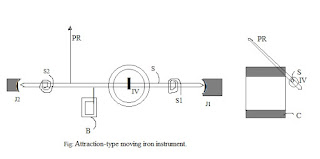Repulsion principle is very commonly used in MI instruments.The operation of such an instruments depends upon the mutual repulsion of two vanes of ferromagnetic material magnetize by a current-carrying coil.Fig shows a typical form of a repulsion-type MI instrument.It consists of a fixed coil C in which are placed two vanes A and B.Vane A is fixed in space while vane B is attached to a spindle S carrying a pointer PR.When the current to be measured is passed though the coil a magnetic field is produced.This magnetic field magnetizes the two vanes with the same polarity.Hence the vanes repel each other,with the result that the pointer is deflected.
The deflection depends on the product of the pole strengths of A and B.It is therefore proportional to the square of the magnetic field strength.Since both A and B are magnetized by the same coil current,the deflection is proportional to the square of the current.It is assumed that A and B are not magnetically saturated.Since the polarity of both the vanes reverse simultaneously,the deflection of the pointer is in the same direction for both a.c. and d.c.If a.c. is passed through the coil the deflecting torque is proportional to the mean value of the square of the current.The scale is calibrated to indicate the square root of this value for d.c. and the r.m.s. value for a.c.























